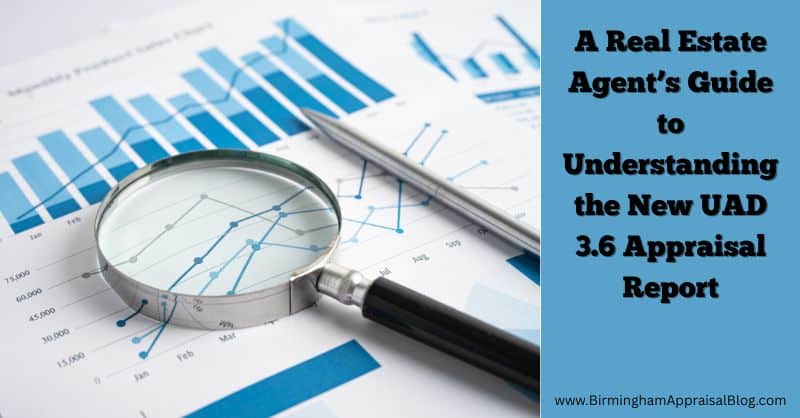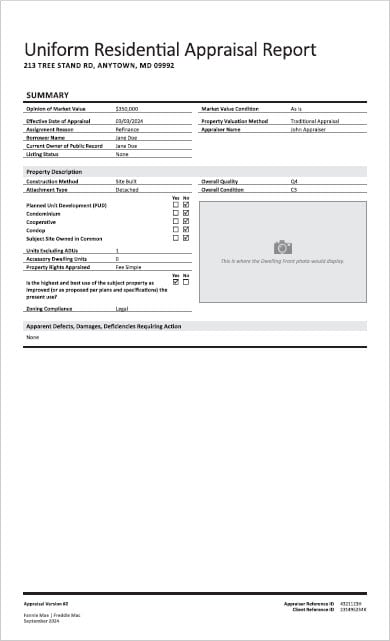Why This Matters to Agents
You’ll start seeing something new in appraisal reports soon: the UAD 3.6 appraisal report. It’s a big change in how appraisals are written and shared.

This update doesn’t just affect appraisers. It also changes how agents, buyers, and sellers read and understand the report.
I recently spoke with an office of real estate agents discussing the new UAD 3.6 and how it affects them. I thought I would create this post to help educate other agents who are interested in learning more about this new report format.
If you haven’t seen the new report yet, don’t worry. In this post, I’ll walk you through what’s new and what it means for you. My goal is to make this easy to follow so you can feel confident explaining the report to your clients.
You can DOWNLOAD a sample UAD 3.6 by clicking the report graphic below.
1. What’s New in UAD 3.6
Basically, the UAD 3.6 appraisal report is a complete update to how information is collected and presented. Fannie Mae and Freddie Mac created this new format to make reports easier to read, more consistent, and better suited for modern technology.
In the past, appraisers used different forms depending on the property type, such as single-family, condominium, or manufactured home. That’s changing. The new system uses one standard report that adjusts automatically to fit the property and assignment type.
You won’t have to flip between different forms that all look slightly different. The new layout is more consistent.
You’ll also notice:
- Fewer confusing abbreviations and codes.
- Clearer sections that show how the appraiser reached their opinion of value.
- Photos, maps, and sketches that line up with the information they describe.
Agent Action Step:
✓ Expect appraisal reports that look different but are easier to read. The same details are there, but it will be easier to find the information you’re looking for.
2. Why the Change?
The old appraisal format has been around since 2011. In appraisal years, that’s a long time.
Back then, reports used checkboxes and short phrases that didn’t always explain things in the clearest way. The new version changes that. Today’s lenders and appraisers rely on better data, and everyone will benefit from the better-organized report.
The UAD 3.6 appraisal report makes that possible. It brings more clarity and consistency so everyone—appraisers, lenders, and agents—sees the same information and understands what it means.
Agent Action Step:
✓ When a client asks why the appraisal looks so different, explain that it’s part of a nationwide update to make reports clearer and more consistent for everyone.
3. Key Sections to Know in the New UAD 3.6 Appraisal Report
Let’s take a look at the areas agents will notice most and how they can help you when reviewing a report.
a. Property Details
This section lists the basic facts about the property: square footage, bedrooms, baths, and lot size.
The difference is that the new report uses clearly labeled fields instead of long paragraphs. You’ll be able to find what you’re looking for faster and without extra digging.
It’s straightforward and easy to scan—something every busy agent can appreciate.
b. Quality and Condition Ratings
The familiar Quality (Q1–Q6) and Condition (C1–C6) ratings are still there, but they now include plain-language explanations.
Appraisers can add short comments to support their ratings. So instead of just seeing “C3,” you might see something like, “Normal wear for its age with an updated kitchen and baths.”
That extra detail makes it easier for agents to explain the findings to clients.
c. Comparable Sales and Adjustments
This section shows how the appraiser compared the subject property to recent sales.
The new version uses a cleaner, more consistent grid, making differences easier to see. Adjustments stand out, and you’ll have an easier time following the appraiser’s reasoning.
If you’ve ever had to flip back and forth through pages to figure out how adjustments were made, this change will be a welcome one.
d. Photos, Maps, and Sketches
Photos and maps now appear next to the parts of the report they describe. You’ll see the map of comparable sales right by the sales grid instead of several pages later.
This small change makes a big difference when you’re reviewing the report and trying to follow the appraiser’s thought process.
Agent Action Step:
✓ When reviewing a report, use the section headings to guide you. The new layout was designed to help you find what you need faster.
4. How It Helps Agents
For agents, the biggest benefit of the UAD 3.6 appraisal report is clarity.
It’s easier to see how the appraiser arrived at the opinion of value without getting lost in technical terms.
Here’s what that means for you:
- Easier conversations with buyers and sellers about how value was determined.
- Fewer misunderstandings when the appraised value is higher or lower than expected.
- A clearer picture of how updates and repairs were considered.
Agent Action Step:
✓ Use the new layout to your advantage. When talking about the appraisal with your client, focus on what the report actually says about condition, quality, and comparable sales.
5. Tips for Communicating with Clients
Here’s how you can use what’s in the UAD 3.6 appraisal report to make conversations with your clients easier.
- Translate the language. If a report says the property is rated “C3,” explain that it means the home has normal wear for its age, not that something’s wrong.
- Read the comments. The new reports have short explanations under the condition and quality ratings. They tell you what improvements or updates were considered.
- Stay calm about differences. Every appraiser has to make judgment calls. The new layout just makes those differences easier to see.
Agent Action Step:
✓ Before you call your client, read the summary and comment sections. They give you the quick version of what matters most.
6. How Agents Can Prepare Listing Information to Align with UAD 3.6
Accurate MLS information is more important than ever. The new UAD format matches up closely with MLS fields, so what you enter directly affects how an appraiser sees the property.
Here’s what to double-check before hitting “submit” on your next listing:
- Square footage: Use a professional measurement when possible.
- Updates and renovations: Include what was done, when, and what materials were used.
- Condition and quality: Be honest and consistent. Avoid terms like “fully remodeled” unless the home truly is.
- Photos: Use clear, well-lit photos that show upgrades or special features.
When your listing data matches what’s in the appraisal, this enhances the consistency of the data, which makes the process smoother.
Agent Action Step:
✓ Review your listings for accuracy. Even small details, like the year of a roof replacement, can help the appraiser produce a more accurate report.
7. The Bigger Picture: What to Expect Going Forward
Don’t expect every report to look different overnight. The switch to the UAD 3.6 appraisal report will take time.
For a while, you’ll probably see both old and new versions. That’s normal. The change is being rolled out gradually to make the transition easier.
Once the new format is fully in place, everyone—appraisers, agents, and lenders—will be looking at the same report. That means fewer surprises and smoother transactions.
Conclusion: Confidence Through Understanding
The UAD 3.6 appraisal report might look different, but it was created to make things easier, not harder. The new layout is cleaner, the language is clearer, and the information is easier to find.
When you understand how the report is organized, you can explain it better to your clients, and that builds trust. In short, the more familiar you are with the new format, the easier your job becomes when guiding buyers and sellers through the appraisal process. If I can answer any appraisal questions for you, please contact me, and as always, thanks for reading.

Speak Your Mind